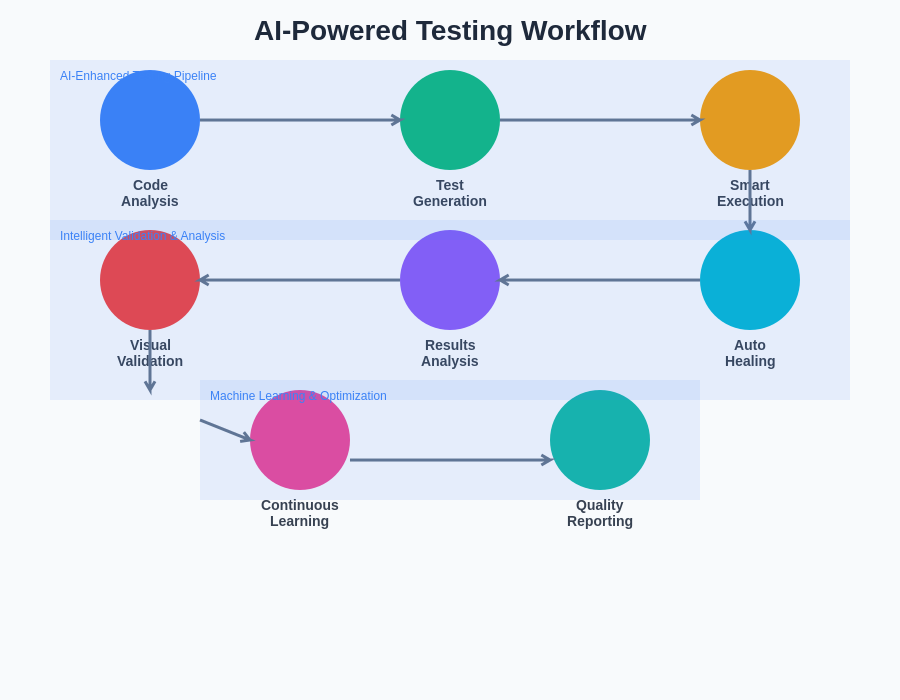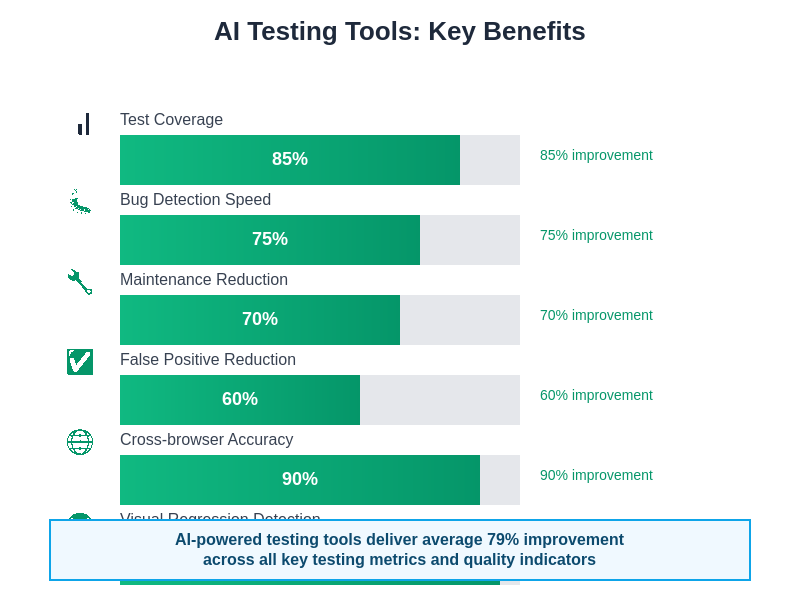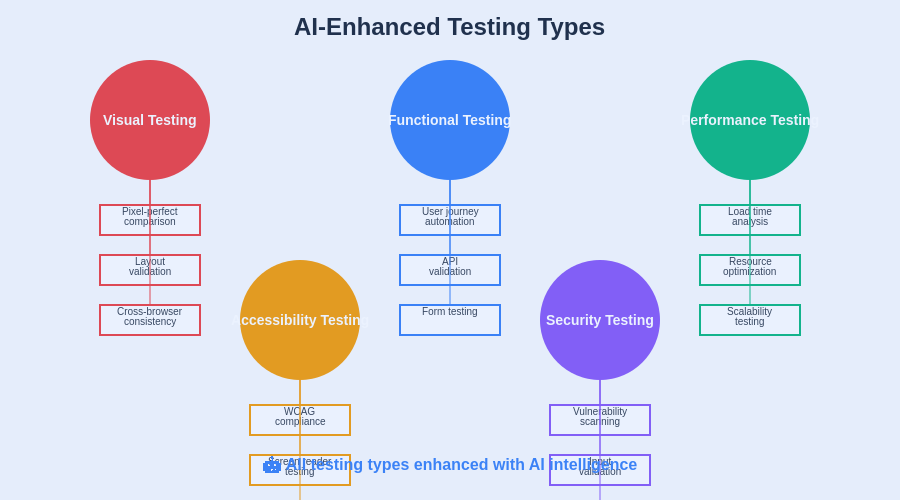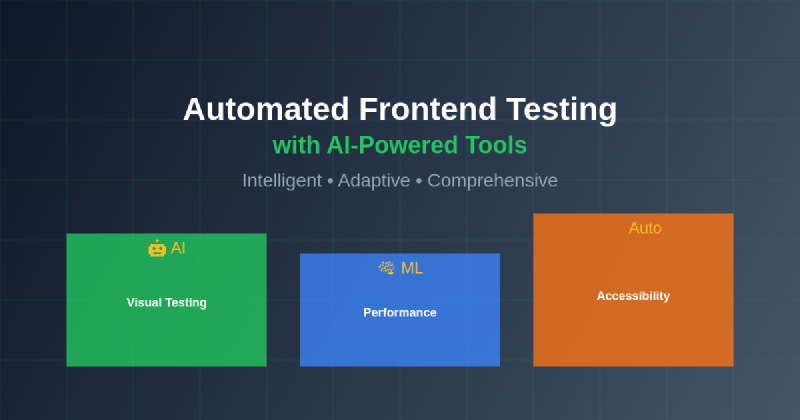The evolution of frontend testing has reached a pivotal moment where artificial intelligence is fundamentally transforming how developers approach quality assurance in web applications. Traditional testing methodologies, while effective, often struggle to keep pace with the rapid development cycles and complex user interfaces that characterize modern web development. AI-powered testing tools have emerged as game-changing solutions that not only automate repetitive testing tasks but also introduce intelligent analysis, predictive capabilities, and adaptive testing strategies that significantly enhance the reliability and efficiency of frontend quality assurance processes.
Explore the latest AI testing innovations to stay informed about cutting-edge developments in automated testing technologies that are reshaping quality assurance practices across the industry. The integration of artificial intelligence into frontend testing represents a fundamental shift from reactive bug detection to proactive quality enhancement, enabling development teams to deliver more robust and reliable user experiences while reducing the time and resources traditionally required for comprehensive testing coverage.
The Foundation of AI-Enhanced Frontend Testing
The traditional landscape of frontend testing has long been characterized by manual processes, brittle test scripts, and the constant challenge of maintaining test suites that can adapt to rapidly changing user interfaces. AI-powered testing tools have introduced a new paradigm that addresses these fundamental limitations through intelligent automation, machine learning-driven test generation, and sophisticated analysis capabilities that can understand and adapt to complex frontend architectures. These advanced systems leverage natural language processing, computer vision, and predictive analytics to create testing solutions that are not only more efficient but also more comprehensive and resilient to change.
The foundation of AI-enhanced frontend testing rests on the ability of machine learning algorithms to understand user interface patterns, identify critical user journeys, and automatically generate test scenarios that cover both expected functionality and edge cases that human testers might overlook. This intelligent approach to test creation eliminates many of the manual bottlenecks that have traditionally slowed down testing processes while simultaneously improving test coverage and reliability. The result is a testing ecosystem that can scale with development velocity while maintaining rigorous quality standards.
Intelligent Test Generation and Maintenance
One of the most significant advantages of AI-powered frontend testing tools lies in their ability to automatically generate comprehensive test suites based on application behavior and user interaction patterns. These systems analyze existing applications, understand user workflows, and create detailed test scenarios that cover critical functionality without requiring extensive manual configuration. The intelligent test generation process considers multiple factors including user interface complexity, business logic requirements, and common usage patterns to produce test suites that are both thorough and relevant to real-world application usage.
The maintenance aspect of AI-generated tests represents another crucial advancement in testing technology. Traditional test suites often become fragile when applications undergo interface changes, requiring significant manual effort to update and maintain test scripts. AI-powered tools address this challenge through adaptive maintenance capabilities that can automatically adjust test parameters, update element selectors, and modify test flows in response to application changes. This self-healing capability dramatically reduces the overhead associated with test maintenance while ensuring that test suites remain accurate and effective over time.
Enhance your development workflow with Claude’s advanced AI capabilities for intelligent code analysis and testing strategy development that complements automated testing tools. The combination of AI-powered testing platforms with intelligent development assistants creates a comprehensive quality assurance ecosystem that addresses every aspect of frontend application reliability and performance.
Visual Regression Testing and UI Anomaly Detection
Visual regression testing has emerged as one of the most compelling applications of artificial intelligence in frontend testing, addressing the critical challenge of detecting unintended visual changes that can significantly impact user experience. AI-powered visual testing tools employ sophisticated computer vision algorithms to analyze application screenshots, identify visual differences, and determine whether detected changes represent legitimate updates or problematic regressions. This capability extends far beyond simple pixel-by-pixel comparison, incorporating intelligent analysis that can distinguish between meaningful visual changes and inconsequential variations caused by factors such as font rendering differences or minor layout adjustments.
The anomaly detection capabilities of AI-powered visual testing tools represent a significant advancement over traditional approaches to interface validation. These systems can identify subtle visual inconsistencies, accessibility issues, and design deviations that might escape human observation during manual testing processes. By analyzing patterns across multiple browsers, devices, and screen resolutions, AI-powered tools can detect cross-platform compatibility issues and ensure consistent visual presentation across diverse user environments. This comprehensive approach to visual validation helps maintain brand consistency and user experience quality while reducing the manual effort required for thorough visual testing.
Predictive Analytics and Test Optimization
The integration of predictive analytics into frontend testing workflows has introduced powerful capabilities for optimizing test execution strategies and identifying potential quality issues before they manifest in production environments. AI-powered testing platforms analyze historical test data, code change patterns, and application usage metrics to predict which areas of an application are most likely to contain defects or experience issues. This predictive approach enables development teams to focus testing efforts on high-risk areas while optimizing resource allocation and reducing overall testing time.
Test optimization through machine learning algorithms represents another significant advancement in AI-powered frontend testing. These systems continuously analyze test execution results, identify redundant or ineffective tests, and recommend optimizations that improve test suite efficiency without compromising coverage. By understanding which tests provide the most value and which combinations of tests offer optimal risk coverage, AI-powered tools help development teams create more focused and effective testing strategies that deliver better results with fewer resources.
Cross-Browser and Cross-Device Intelligence
The complexity of modern web development requires thorough testing across multiple browsers, devices, and operating systems to ensure consistent user experiences. AI-powered testing tools have revolutionized cross-browser and cross-device testing by intelligently prioritizing test execution based on user analytics, market share data, and historical defect patterns. These systems can automatically determine which browser and device combinations are most critical for specific applications and optimize testing coverage accordingly.
The intelligent prioritization capabilities of AI-powered testing platforms extend beyond simple market share analysis to consider factors such as user behavior patterns, conversion rates, and business impact metrics. This sophisticated approach to test prioritization ensures that testing resources are allocated most effectively while maintaining comprehensive coverage of critical user scenarios. Additionally, AI-powered tools can identify browser-specific issues and device-specific behaviors that might be missed by traditional testing approaches, providing more thorough validation of cross-platform functionality.
Leverage Perplexity’s research capabilities to stay informed about emerging browser technologies and device trends that impact frontend testing strategies. The rapid evolution of web technologies requires continuous adaptation of testing approaches, and AI-powered tools provide the flexibility and intelligence needed to maintain effective testing coverage across evolving technology landscapes.
Natural Language Test Specification
The democratization of test creation through natural language processing represents a transformative development in AI-powered frontend testing. These advanced systems enable non-technical stakeholders to contribute to test specification by describing desired application behavior in plain English, which the AI then translates into executable test scenarios. This capability bridges the communication gap between business requirements and technical implementation while enabling broader participation in the quality assurance process.
Natural language test specification goes beyond simple command translation to incorporate intelligent interpretation of business logic, user workflows, and application context. AI-powered tools can understand complex scenarios described in natural language and generate comprehensive test suites that cover both explicit requirements and implicit expectations. This approach not only accelerates test creation but also improves the alignment between business objectives and testing coverage, ensuring that automated tests validate the most important aspects of application functionality.
Continuous Learning and Adaptation
The continuous learning capabilities of AI-powered frontend testing tools represent a fundamental advancement over static testing approaches. These systems analyze test execution results, application changes, and user feedback to continuously improve their testing strategies and adapt to evolving application requirements. Machine learning algorithms identify patterns in test failures, success rates, and application behavior to refine test generation algorithms and optimize testing approaches over time.
The adaptive nature of AI-powered testing tools enables them to evolve alongside the applications they test, maintaining effectiveness even as software architectures and user requirements change. This continuous improvement process includes learning from false positives, adapting to new interface patterns, and incorporating insights from production issues to strengthen future testing coverage. The result is a testing ecosystem that becomes more intelligent and effective with each testing cycle.
Integration with Development Workflows
The seamless integration of AI-powered testing tools into existing development workflows has been crucial to their adoption and effectiveness. These tools are designed to work within popular continuous integration and continuous deployment pipelines, providing automated feedback that enables rapid iteration while maintaining quality standards. The intelligent scheduling and execution capabilities of AI-powered testing platforms ensure that testing activities complement rather than impede development velocity.
Modern AI-powered testing tools provide sophisticated reporting and analytics capabilities that give development teams actionable insights into application quality and testing effectiveness. These systems can identify trends in test results, highlight areas of concern, and provide recommendations for improving both application quality and testing strategies. The integration of AI-powered testing into development workflows creates a feedback loop that continuously improves both the application and the testing process itself.

This comprehensive workflow demonstrates how artificial intelligence enhances every stage of the testing process, from initial code analysis through continuous learning and optimization. The interconnected nature of AI-powered testing creates a self-improving system that becomes more effective with each testing cycle.
Performance Testing and Load Analysis
AI-powered tools have extended their capabilities beyond functional testing to include sophisticated performance analysis and load testing optimization. These systems can intelligently generate realistic load scenarios based on actual user behavior patterns, identify performance bottlenecks, and predict how applications will perform under various stress conditions. The machine learning algorithms analyze performance metrics, user interaction patterns, and system resource utilization to create comprehensive performance testing strategies that reflect real-world usage conditions.
The predictive performance analysis capabilities of AI-powered testing tools enable development teams to identify potential scalability issues before they impact users. These systems can analyze code changes, infrastructure modifications, and usage trends to predict performance implications and recommend optimizations. This proactive approach to performance validation helps ensure that applications can handle expected load increases while maintaining responsive user experiences.
Security Testing and Vulnerability Detection
The integration of AI-powered security testing capabilities into frontend testing workflows has become increasingly important as web applications face evolving security threats. AI-powered tools can automatically identify potential security vulnerabilities, analyze authentication flows, and validate data protection mechanisms. These systems employ machine learning algorithms to recognize common attack patterns, identify suspicious behavior, and ensure that security controls are properly implemented and maintained.
The intelligent vulnerability detection capabilities of AI-powered testing tools extend beyond traditional security scanning to include analysis of user interface vulnerabilities, client-side security issues, and privacy protection mechanisms. These systems can identify potential data exposure risks, validate input sanitization, and ensure that security controls remain effective as applications evolve. This comprehensive approach to security testing helps development teams maintain robust security postures while delivering rich user experiences.
Accessibility Testing and Compliance Validation
AI-powered testing tools have made significant contributions to accessibility testing by automating the detection of accessibility issues and ensuring compliance with relevant standards and regulations. These systems can analyze user interfaces for accessibility barriers, validate keyboard navigation, and ensure that applications are usable by individuals with diverse abilities. The machine learning algorithms understand accessibility best practices and can identify potential issues that might be missed by manual testing approaches.
The comprehensive accessibility analysis capabilities of AI-powered tools include evaluation of color contrast, screen reader compatibility, and assistive technology support. These systems can generate detailed accessibility reports, provide recommendations for improvements, and track compliance metrics over time. This automated approach to accessibility testing helps development teams create inclusive applications while maintaining compliance with accessibility standards and regulations.

The quantitative benefits of implementing AI-powered testing tools are substantial across all key performance indicators. Development teams consistently experience significant improvements in test coverage, bug detection speed, maintenance efficiency, and overall testing accuracy when adopting intelligent testing solutions.

AI enhancement transforms every category of frontend testing, from visual validation to security assessment. Each testing type benefits from intelligent automation, adaptive capabilities, and sophisticated analysis that traditional testing approaches cannot match.
Future Directions and Emerging Capabilities
The future of AI-powered frontend testing promises even more sophisticated capabilities as machine learning algorithms become more advanced and computing resources continue to expand. Emerging developments include more sophisticated natural language understanding, enhanced visual analysis capabilities, and improved integration with development tools and workflows. These advancements will further reduce the barriers to comprehensive testing while improving the accuracy and effectiveness of automated quality assurance processes.
The evolution of AI-powered testing tools is also driving changes in how development teams approach quality assurance, shifting from reactive bug fixing to proactive quality enhancement. Future developments are likely to include more sophisticated predictive capabilities, enhanced collaboration features, and deeper integration with artificial intelligence development assistants. These advancements will create even more powerful testing ecosystems that support the delivery of high-quality web applications while reducing the time and resources required for comprehensive quality assurance.
The transformation of frontend testing through artificial intelligence represents more than just technological advancement; it signifies a fundamental shift toward more intelligent, efficient, and effective quality assurance practices. As AI-powered testing tools continue to evolve, they will play an increasingly important role in enabling development teams to deliver exceptional user experiences while maintaining rapid development velocity and rigorous quality standards. The future of frontend testing lies in the intelligent collaboration between human expertise and artificial intelligence capabilities, creating testing environments that are both more capable and more adaptable to the evolving needs of modern web development.
Disclaimer
This article is for informational purposes only and does not constitute professional advice. The views expressed are based on current understanding of AI technologies and their applications in frontend testing. Readers should conduct their own research and consider their specific requirements when implementing AI-powered testing tools. The effectiveness of AI-assisted testing may vary depending on specific use cases, application complexity, and team expertise levels.
